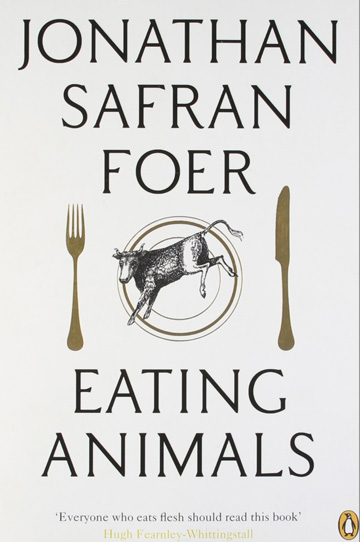The birth of his first child posed a painful quandary for novelist Jonathan Safran Foer: Would he serve turkey at his son’s first Thanksgiving? In “Eating Animals,” a work of nonfiction, Foer (author of “Everything is Illuminated” and “Extremely Loud & Incredibly Close”) confesses to a lifelong ambivalence toward eating meat. Yet he cherishes memories of childhood meals at his grandmother’s house. At what point, he wonders, should ethical decisionmaking supplement, rather than supersede, rich and important traditions at table?
Spurred by the arrival of his son, Foer set out to decide. He spoke with animal and agribusiness authorities; visited farms and slaughterhouses; and even donned his muckraking boots, breaking into a turkey warehouse along with an animal activist in the middle of the night. But what began as a silly adventure ended in heartbreak: Foer and his friend discovered a barn floor covered with tens of thousands of turkey chicks, many of them deformed, seriously injured, or expired, “as desiccated and loosely gathered as small piles of dead leaves.” The book’s tone evolves from twee precocity to stunned outrage to profound grief as Foer acquaints himself with the suffering endured by the tens of billions of animals bred for our food each year. Should he pass this system on to the next generation?
“No turning away,” he challenges the reader before frankly confronting unspeakable but routine horrors of the factory farm, which produces 99 percent of America’s meat, dairy, and eggs. Most pigs and chickens in the United States are confined so tightly for their entire lives that they can barely move. The modern slaughterhouse “processes” over 5,000 chickens an hour, 400 cows an hour, and pigs at the rate of one every three or four seconds. And the line does not stop. It is physically impossible, Foer argues, to kill animals humanely at these speeds, which is why 180 million chickens are improperly slaughtered every year, and cows regularly “are bled, skinned, and dismembered while conscious.” Throughout, one is struck by Foer’s eloquence. As a novelist, he has turned his formidable powers of expression to the seemingly infinite problem of animal suffering.
Yet “Eating Animals” is not “a straightforward case for vegetarianism.” Foer celebrates those few remaining animal farmers who still practice genuine stewardship. But he recognizes that continuing to eat meat means supporting factory farms whenever he does not buy locally. And so he ultimately confronts a choice. Returning to Thanksgiving, he imagines: “There is no turkey. Is the holiday undermined? Is Thanksgiving no longer Thanksgiving? Or would Thanksgiving be enhanced? Would the choice not to eat turkey be a more active way of celebrating how thankful we feel? Try to imagine the conversation that would take place: This is why our family celebrates this way. Would such a conversation feel disappointing or inspiring?”
In the end, Foer suggests that it is not quite a cop-out to keep eating meat, as Michael Pollan prescribed in “The Omnivore’s Dilemma,” on the rationale that we have always done so with friends and loved ones on important occasions. These are significant values that are not easily outweighed. But they do not in turn dwarf every competing concern. “Eating Animals” makes the plaintive case that if history and tradition are not exactly trumped by animal suffering, they certainly ought to be informed by it. After all, nothing enhances fellowship like a little moral ambition.







